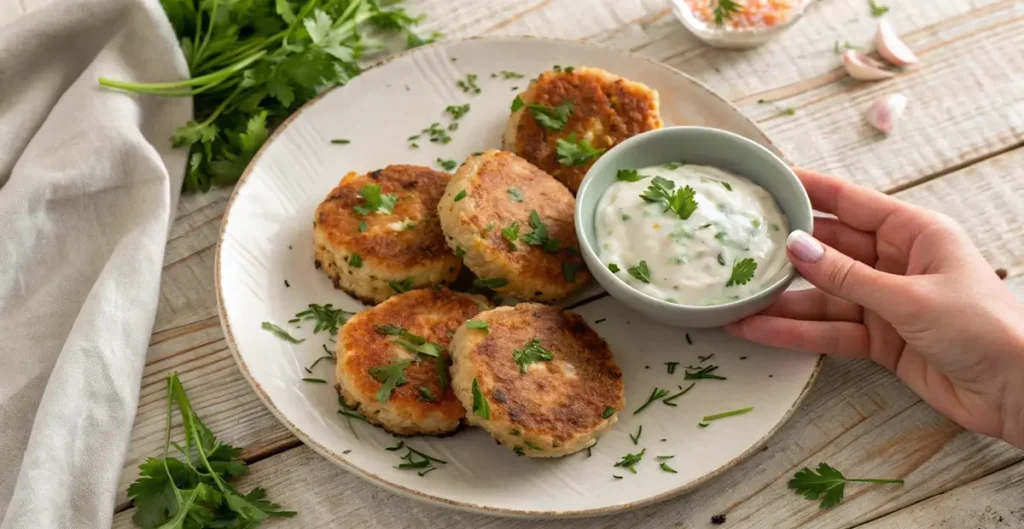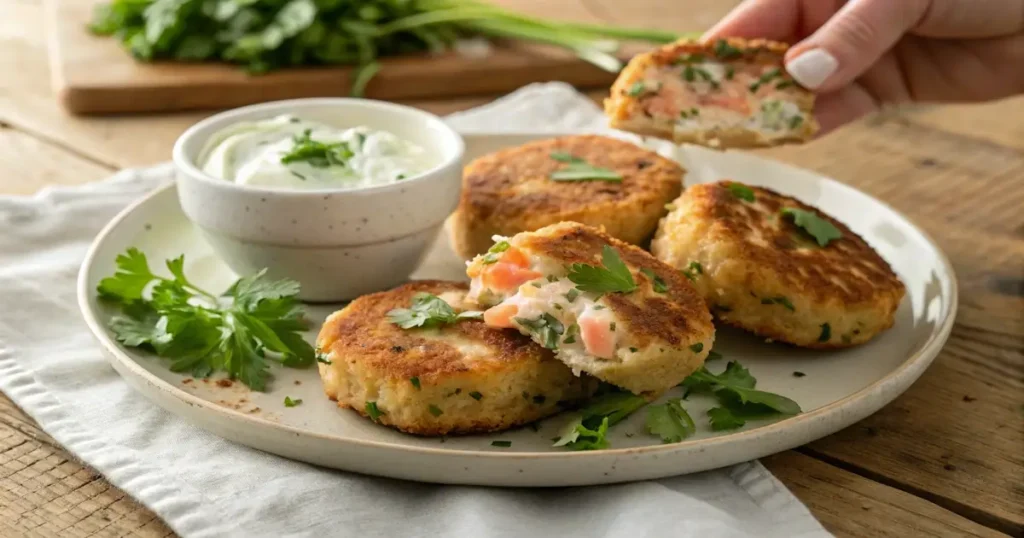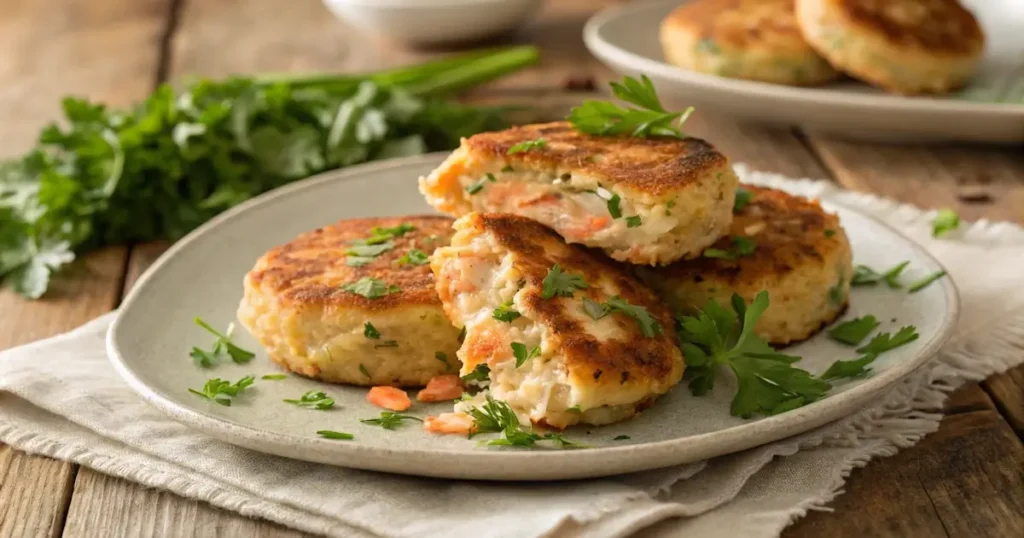Salmon cakes are a tasty and adaptable dish that can be prepared using fresh or canned salmon. Whether you’re looking for a quick weeknight meal or a savory dish for a special occasion, this recipe offers the perfect balance of flavor and nutrition. These salmon cakes taste amazing, but they’re also packed with health benefits—thanks to the heart-healthy omega-3 fatty acids and high-quality protein in salmon. In this guide, we’ll walk you through the steps to create crispy, flavorful salmon cakes that will surely please everyone at your table. And the best part? You can use either fresh or canned salmon, making it easy to adapt the recipe based on what you have on hand. Ready to get cooking? Now, let’s explore the delicious world of salmon cakes!
Table of Contents
1. Recipe Name and Its Health Benefits
Why Fresh or Canned Salmon is a Healthy Choice for Salmon Cakes
When it comes to making salmon cakes, salmon is one of the key ingredients that makes this dish stand out. Whether you use fresh or canned salmon, both options provide exceptional health benefits. Fresh salmon contains omega-3 fatty acids, essential for heart health, reducing inflammation, and promoting cognitive function. Omega-3s are also known to improve skin health, boost immunity, and may even help lower the risk of chronic diseases like heart disease and arthritis.
On the other hand, canned salmon is an equally healthy option and a great pantry staple. It offers many health benefits, such as fresh salmon, which is rich in high-quality protein and essential nutrients like vitamin D, B12, and selenium. Canned salmon is also incredibly convenient, affordable, and easily stored for longer periods, making it an ideal choice for busy families or individuals who may not always have access to fresh fish.
By choosing fresh or canned salmon for your salmon cakes, you’re getting a delicious, nutrient-dense meal that supports your overall health. Plus, the rich flavor of the fish pairs perfectly with the crispy texture of the cakes, making this dish both a culinary and healthful delight.
Health Benefits of Salmon Cakes: Omega-3s and Protein Power

Salmon cakes are not just tasty—they’re a powerhouse of nutrition. They’re so beneficial mainly due to the rich content of omega-3 fatty acids and protein found in salmon. Let’s break down the key health benefits of including salmon cakes in your diet:
- Rich in Omega-3 Fatty Acids: Salmon is one of the best sources of omega-3s, essential for maintaining heart health. These healthy fats help reduce bad cholesterol levels, lower blood pressure, and support healthy circulation. Omega-3s are also linked to improved brain function, which is particularly important for cognitive health as we age. Regular consumption of omega-3s can even help reduce the risk of depression, anxiety, and certain mental disorders.
- High-Quality Protein for Muscle and Tissue Repair: Protein is a crucial nutrient for building and repairing tissues, and salmon is an excellent source of lean protein. Protein helps grow and maintain muscles, making salmon cakes a great choice for athletes, active individuals, and anyone looking to maintain a healthy body composition. It also supports the immune system, allowing your body to better defend against illness.
- Packed with Essential Vitamins and Minerals: Salmon cakes contain vital nutrients such as vitamin D, B12, and selenium. Vitamin D supports bone health and immune function, while vitamin B12 is essential for energy production and red blood cell formation. Selenium is an antioxidant that protects your body from oxidative stress and supports thyroid function.
Salmon cakes nourish your body with these powerful nutrients while indulging in a satisfying meal. Combining omega-3s and protein offers long-term health benefits, making salmon cakes a wise choice for anyone seeking a nutritious and delicious dish.
2. Tips for Successfully Making the Recipe and Mistakes to Avoid
Tips for Perfectly Crisp Salmon Cakes Every Time
Making the perfect salmon cake isn’t just about the right ingredients; it’s also about getting that ideal crispness on the outside while keeping the inside tender and flavorful. Here are some essential tips to ensure your salmon cakes come out golden, crispy, and absolutely delicious every time:
- Use Panko Bread Crumbs for Extra Crispiness: The breadcrumbs you use can make a big difference when making salmon cakes. Panko bread crumbs, the Japanese-style crumbs, are lighter and flakier than regular bread crumbs. This gives your cakes an extra crunch without becoming too heavy. Be sure to coat the cakes in panko crumbs on both sides before cooking to get that perfectly crisp exterior.
- Don’t Overmix the Ingredients: While it’s tempting to mix the ingredients until everything is fully incorporated, overmixing can result in dense and heavy salmon cakes. Instead, gently combine the salmon, breadcrumbs, and seasonings to maintain a light and airy texture. Overmixing also can cause the salmon cakes to fall apart during cooking, so be careful not to handle the mixture too much
- Chill the Salmon Cake Mixture Before Cooking: Chilling the salmon cake mixture for at least 30 minutes before shaping and cooking helps the cakes retain their shape during frying. The cold mix allows the ingredients to firm up, making it easier to form the cakes and preventing them from falling apart in the pan.
- Use the Right Amount of Oil and Heat: You need the right amount of heat and oil for that perfect crispy crust. Use good-quality olive or vegetable oil to fry the cakes, ensuring the oil is hot but not smoking. If the heat is too low, the cakes absorb too much oil and become greasy. If it’s too high, they may burn before cooking through. Medium-high heat is ideal for achieving a golden-brown crust and evenly cooked salmon cakes.
- Don’t Crowd the Pan: Avoid overcrowding the pan to achieve a crispy exterior. If you place too many salmon cakes in the skillet at once, they’ll steam rather than fry, resulting in a soggy texture. Cook the cakes in batches if necessary, allowing enough space for each cake to cook properly.
By following these simple tips, you can create salmon cakes that are crisp on the outside, tender on the inside, and full of flavor. Perfecting your technique can take your salmon cakes from good to great every time!
Common Mistakes to Avoid When Making Salmon Cakes

Even with the best ingredients, a few common mistakes can prevent your salmon cakes from turning out as delicious as you’d hoped. Be mindful of these common errors and how to steer clear of them:
- Using Too Much Moisture in the Mixture: One of the most common mistakes when making salmon cakes is adding too much moisture to the mixture. While ingredients like mayonnaise and Worcestershire sauce add flavor, too much can make the cakes too wet and cause them to fall apart when cooking. Be sure to measure the wet ingredients accurately and avoid over-saturating the salmon mixture. If you find the mixture too moist, add more Panko breadcrumbs to help bind it together.
- Not Using Fresh Salmon or Quality Canned Salmon: The flavor and texture of your salmon cakes largely depend on the quality of the salmon you use. Fresh salmon can deliver a richer, more delicate flavor, but not all canned salmon are created equal. Choose wild-caught varieties with no added preservatives or artificial ingredients for the best taste and nutrition when choosing canned salmon. Avoid overly processed or low-quality salmon, as this can negatively impact the flavor and texture of your cakes.
- Overcooking the Salmon Cakes: Overcooking is a mistake many home cooks make when trying to achieve the perfect salmon cake. It’s easy to get carried away with trying to get the cakes extra crispy, but overcooking can result in dry, tough cakes. Salmon cakes should be cooked until golden brown on both sides, but they don’t need to be in the pan for too long. If your cakes start to brown too quickly, lower the heat slightly to ensure the insides cook thoroughly without burning the exterior.
- Using the Wrong Cooking Method: While frying salmon cakes in oil is the most common method, some people try to bake or broil them as a shortcut. While these methods can work, they don’t always produce the same crispy, golden-brown exterior. For the best results, pan-fry your salmon cakes in a hot skillet with a small amount of oil. If you prefer a healthier option, you can bake them, but lightly brush them with oil before placing them in the oven for a crispy finish.
- Skipping the Resting Time: Don’t rush the process! After shaping your salmon cakes, let them rest for a few minutes before cooking. This resting period allows the cakes to firm up, making them easier to handle in the pan and reducing the risk of falling apart during cooking. Resting also gives the flavors time to meld together, making for a more cohesive and flavorful cake.
By avoiding these common mistakes, you’ll be well on your way to making perfect salmon cakes that are crispy, flavorful, and satisfying every time. Patience and attention to detail will ensure your salmon cakes turn out just right!
3. Ingredients and Quantities for the Recipe and Preparation Steps
Essential Ingredients for Salmon Cakes: What You’ll Need

Making salmon cakes requires just a few simple ingredients, but each one plays a crucial role in achieving the perfect flavor and texture. Here’s a breakdown of the essential ingredients you’ll need for this recipe:
- Fresh Salmon Fillet (1 lb): The show’s star! Fresh salmon fillet contains omega-3 fatty acids, protein, and essential vitamins. Remove any bones and skin before chopping it into bite-sized pieces if fresh salmon is used. Fresh salmon will provide a tender, flavorful base for your cakes. However, high-quality canned salmon is an excellent substitute if fresh salmon isn’t available.
- Garlic Salt (to taste): For added seasoning, garlic salt brings a savory, aromatic flavor to the salmon cakes. You can use regular garlic powder and salt separately, but garlic salt gives the cakes an even more consistent taste.
- Black Pepper (to taste): A bit of black pepper adds a subtle heat and depth of flavor that complements the salmon’s richness. Adjust the amount depending on your taste preferences, but don’t go overboard—just a pinch is enough to enhance the other flavors.
- Olive Oil (for cooking): Olive oil is ideal for cooking salmon cakes due to its rich, robust flavor and health benefits. It adds extra flavor when frying the cakes, helping achieve a crisp, golden-brown exterior. Be sure to use enough oil to coat the bottom of the pan but not too much to soak the cakes.
- Medium Onion (1 cup, finely diced): Diced onion provides a mild, sweet flavor that complements the salmon’s savory taste. The onion softens during cooking, adding moisture to the cakes and helping bind the ingredients. Use a medium onion for the perfect balance of flavor without overwhelming the dish.
- Red Bell Pepper (1/2, diced): Red bell pepper adds color, crunch, and a subtle sweetness to the salmon cakes. It also pairs well with the salmon and other ingredients, adding freshness and contrast to the richness of the fish.
- Unsalted Butter (3 Tbsp, divided): Butter adds a rich, creamy flavor to the salmon cakes, helping to keep them moist. By using unsalted butter, you can control the salt content of the cakes. Butter is also great for frying the cakes, giving them a crispy, golden texture.
- Panko Bread Crumbs (1 cup, Japanese Style): Panko bread crumbs are essential for achieving the perfect crispy texture outside the salmon cakes. These light, flaky crumbs create a delicate crust without making the cakes too heavy. They’re ideal for making salmon cakes crispy and light while allowing the salmon flavor to shine.
- Large Eggs (2, lightly beaten): Eggs act as a binder, helping hold all the ingredients together. They contribute to the structure and ensure the salmon cakes remain intact during cooking. Lightly beat the eggs before mixing them into the salmon mixture.
- Mayonnaise (3 Tbsp): Mayonnaise adds creaminess and helps keep the salmon cakes moist. It also serves as a binder, keeping the ingredients together. You can use Greek yogurt instead of mayonnaise for a tangier flavor if you prefer a healthier alternative.
- Worcestershire Sauce (1 tsp): Worcestershire sauce adds a savory flavor to the salmon cakes. It brings a slight tanginess and enhances the salmon’s umami, making the cakes even more flavorful.
- Minced Fresh Parsley (1/4 cup): Fresh parsley brings a lively burst of flavor and a subtle herbal essence to the salmon cakes. It also makes the cakes look vibrant and colorful. Parsley is the perfect garnish to finish the dish, enhancing the taste and appearance.
These components come together to produce salmon cakes with a golden, crisp exterior, a tender interior, and a satisfying depth of flavor. Once you have everything ready, you’re just a few steps away from making a delicious meal that’s sure to satisfy!
Step-by-Step Instructions for Making Salmon Cakes

Now that you have all the essential ingredients, it’s time to bring everything together and make those delicious salmon cakes. Here’s a simple, step-by-step guide to follow:
- Prepare the Salmon: Remove any skin and bones if you’re using fresh salmon. Then, chop the salmon into small, bite-sized pieces. Drain and flake the fish with a fork to remove any bones if you’re using canned salmon. Whether fresh or canned, ensure the salmon is well-drained and broken into smaller chunks to ensure even cake distribution.
- Sauté the Vegetables: Heat 1 tablespoon of olive oil and 1 tablespoon of butter over medium heat in a large skillet. Add the diced onion and red bell pepper to the pan, cooking for about 4-5 minutes until the vegetables become tender and aromatic. Remove from heat and let cool slightly.
- Mix the Salmon Cake Ingredients: In a large mixing bowl, combine the prepared salmon, sautéed vegetables, panko bread crumbs, lightly beaten eggs, mayonnaise, Worcestershire sauce, and minced parsley. Season with garlic, salt, and black pepper to your liking. Gently fold everything together until the mixture is well combined, being careful not to overmix. The mixture should be moist but not too wet. If it’s too sticky, add more panko bread crumbs to help bind it.
- Form the Salmon Cakes: Shape the salmon mixture into patties by hand or with a spoon. Aim for about 13-14 cakes, each roughly 2-3 inches in diameter. If the mixture is too sticky, you can wet your hands with a little water to make it easier to shape the cakes.
- Cook the Salmon Cakes: In the same skillet, heat 2 tablespoons of olive oil and 2 tablespoons of butter over medium heat. When the oil is hot, gently place the salmon cakes into the pan. If needed, cook in batches to prevent overcrowding. Fry each cake for 3-4 minutes per side until they’re golden brown and crispy. Ensure the internal temperature reaches 145°F (63°C) to confirm that they are fully cooked.
- Drain and Serve: Once the salmon cakes are cooked, remove them from the skillet and place them on a plate lined with paper towels to drain any excess oil. Serve the salmon cakes warm, optionally topped with some fresh parsley. These cakes pair beautifully with lemon wedges, tartar sauce, or a simple green salad.
These step-by-step instructions ensure that your salmon cakes turn out perfectly crispy on the outside and tender on the inside. Whether cooking for yourself or preparing a meal for your family, this recipe will surely impress!
4. Preserving the Recipe and Frequently Asked Questions (FAQs)
How to Store and Reheat Your Salmon Cakes

Once you’ve made your delicious salmon cakes, you can store leftovers for later or make them beforehand. Follow these guidelines to store and reheat them while preserving their flavor and crispiness:
- Storing Salmon Cakes: To store your salmon cakes, cool them to room temperature before placing them in an airtight container. If you’re storing multiple cakes, place a layer of parchment paper between them to prevent them from sticking together. They will keep well in the refrigerator for up to 3 days. If you need longer storage, freezing them is also an option.
- Freezing Salmon Cakes: To freeze salmon cakes, arrange them in a single layer on a baking sheet and freeze for 1-2 hours or until they’re firm. Once frozen, transfer the cakes to an airtight container or freezer-safe bag. Label them with the storage date to ensure freshness. Frozen salmon cakes can be stored for up to 2-3 months.
- Reheating Salmon Cakes: To reheat refrigerated or frozen salmon cakes, you have a few options:
- On the Stovetop: Heat a small amount of olive oil or butter in a skillet over medium heat. Add the salmon cakes and cook for about 2-3 minutes per side until they’re thoroughly heated and have a crispy exterior. This approach helps preserve their crunchy texture.
- In the Oven: Preheat your oven to 375°F (190°C). Place the salmon cakes on a baking sheet lined with parchment paper and bake for 10-12 minutes, flipping halfway through, until they are warmed.
- In the Microwave: While the microwave is the quickest method, it’s not the best for keeping the crispiness. Place the salmon cakes on a microwave-safe plate and cover them with a paper towel to prevent splattering. Heat them in the microwave for 1-2 minutes, or until warmed through. For a crispier result, you can quickly pan-fry them after microwaving.
By following these storage and reheating tips, you’ll be able to enjoy your salmon cakes even after they’ve been stored for a few days or frozen for a longer period.
FAQs: Common Questions About Making Salmon Cakes
Here are some common questions people have about making salmon cakes, along with helpful answers to guide you:
- Can I use canned salmon instead of fresh salmon?
Absolutely! Canned salmon provides a practical and budget-friendly alternative to fresh salmon. Choose high-quality, wild-caught canned salmon for the best flavor and nutrition. You can use it like fresh salmon in this recipe, making it a perfect option for busy days or when fresh fish is unavailable.
- Can I make these salmon cakes gluten-free?
Yes! To make the recipe gluten-free, substitute the Panko bread crumbs with gluten-free breadcrumbs or ground almonds. You can also make gluten-free breadcrumbs by pulsing gluten-free bread in a food processor. Make sure all other ingredients, such as Worcestershire sauce and mayonnaise, are gluten-free.
- How do I make salmon cakes less greasy?

Make sure the oil is heated to the proper temperature prior to frying; this prevents the salmon cakes from becoming overly oily. If the oil isn’t hot enough, the cakes will soak up excess oil. Additionally, try not to overcrowd the pan when cooking—this allows each cake to crisp up properly without steaming. Once fried, transfer the cakes to paper towels to remove any leftover oil.
- Can I bake the salmon cakes instead of frying them?
Yes, you can bake the salmon cakes for a healthier alternative to frying. Preheat your oven to 375°F (190°C) and place the cakes on a baking sheet lined with parchment paper. Brush the cakes with olive oil to help them crisp up, and bake for about 12-15 minutes, flipping halfway through.
- How can I customize the flavor of my salmon cakes?
Customize the seasoning to match your taste! You can add fresh herbs like dill or thyme for extra flavor or experiment with spices like smoked paprika or cayenne pepper for a kick. You could add some grated Parmesan cheese to the mixture for a richer taste.
- What can I serve with salmon cakes?
Salmon cakes pair wonderfully with a variety of side dishes. For a lighter option, pair them with a crisp salad or tender steamed vegetables. For added flavor, you can also serve them with a tangy tartar sauce, a squeeze of lemon, or even a homemade remoulade. Try pairing them with mashed or roasted potatoes for a more substantial meal.
Conclusion
Salmon cakes made with fresh or canned salmon are delicious and nutritious, perfect for a healthy and satisfying meal. With the right ingredients, key tips, and easy step-by-step instructions, you can create crispy, flavorful salmon cakes that your whole family will love. Whether cooking for a special occasion or a busy weeknight dinner, this recipe provides a versatile and nutritious option to please everyone.
So, the next time you’re looking for a quick, tasty, and nutritious dish, try these salmon cakes—they’re sure to become a favorite in your recipe rotation!

